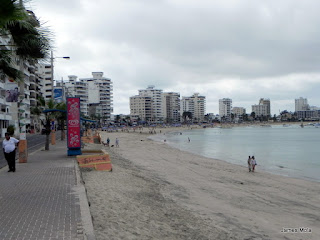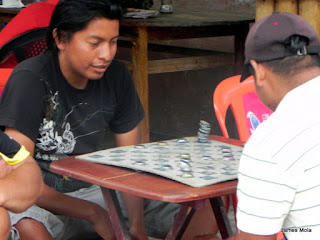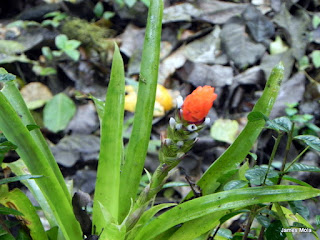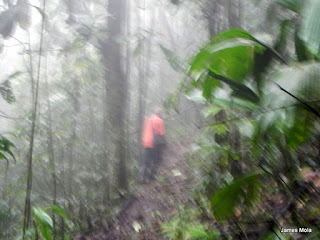I ALSO LEFT OUT A PHOTO OF A WHALE AS IT WAS SUBMERGING BACK INTO THE WATER. I JUST WASN'T FAST ENOUGH TO SPOT THE WHALES, FIND THEM IN MY PHOTO VIEW FINDER, AND SNAP THEM WHILE THEY MIRACULOUS PULLED THEM- SELVES OUT OF THE WATER AND PERFORMED THEIR TWIRL BEFORE SUBMERGING BACK INTO ITS DEPTHS. I HAD SOME VERY GOOD PHOTOS OF MAMMOTH TORTOISES SWIMMING OFF THE BOW OF OUR BOAT. WHEN I REALIZED I HAD LEFT THE PHOTOS OUT, I COULDN'T FIGURE OUT A WAY TO ADD IT TO THE CURRENT POST OF PHOTOS. THANK GOD MY NEXT TWO POSTS WON'T INVOLVE ANY PHOTOS.
 |
| AN OPEN AIR RESTAURANT IN THE HEART OF THE BEACH DISTRICT IN SALINAS, ECUADOR |
A MEAL OF VARIOUS BAKED SEAFOOD ITEMS AT THE RESTAURANT
 |
| SALINAS, ECUADOR |
BEACH FRONT ALONG THE MAIN COASTAL BEACH AREA IN SALINAS, ECUADOR
THE BEACH PROPERTY IN THE FAR LEFT CORNER LITERALLY BANKS UP
AGAINST THE OCEAN.
JET SKIING ON THE PACIFIC OCEAN IN SALINAS, ECUADOR
 |
| WE HAD THE BEACHES (PLAYAS) ALMOST EXCLUSIVELY TO OURSELVES. |
JET SKIING NEAR A BUOY, A NUMBER OF WHICH WERE SETUP IN THE WATER
TO ADVERTISE PRODUCTS, WHILE WARNING SWIMMERS TO GO NO FURTHER.
YACHTS IN THE SALINAS HARBOR
MUSCLE MAN IN A MONTANITA, ECUADOR PLAYGROUND AREA
THE INTERIOR OF A SIMPLE AND ATTRACTIVE CATHOLIC CHURCH
IN MONTANITA, ECUADOR.
MONTANITA OFFERED THE BEST WAVES IN OUR THREE TOWN VISIT FOR SURFERS.
 |
| NATURAL STONE WALL WITH STRUCTURE ON TOP JETTING OUT FROM THE MONTANITA COAST |
GAZEBO IN THE TOWN SQUARE OF MONTANITA
EXTERIOR OF THE CHURCH OFF THE TOWN SQUARE IN MONTANITA
COLORFUL STREET SCENE IN MONTANITA
STREET ENTERTAINERS IN MONTANITA, ECUADOR
 |
| ANYTHING AND EVERYTHING CAN BE PURCHASED IN THE WAY OF SOUVENIRS IN MONTANITA. |
NEED A SURF BOARD. THERE ARE PLENTY ON HAND FOR PURCHASE. THE
TWO YOUNG MEN IN FRONT OF THE BOARD WERE WHAT WAS LEFT AFTER A
GREAT WHITE DINED ON THEIR TORSOS.
THESE HOMBRES ARE PLAYING CHECKERS. EACH WITH HIS OWN DIFFERENT
COLORED SET OF BOTTLE CAPS.
IF YOU HAVE THE MONEY, THEY HAVE WHAT EVER YOU MAY WANT OR STRIKES
YOUR FANCY. LIKE THE TOWN, EVEN THE MERCHANDISE IS HIGHLY COLORFUL.
THESE LIQUOR FLASKS ARE DISTINCTIVE AND ATTRACTIVE IN DESIGN.
 |
| STREET SCENE IN MONTANITA |
ANOTHER STREET SCENE IN MONTANITA
 |
| A RESTAURANT IN MONTANITA WHERE WE ATE TWICE BECAUSE OF THE ATTRACTIVE SETTING. |
SUNSET IN MONTANITA
THE LARGE STONES RANGED THE BREADTH OF THE BEACH AREA IN MONTANITA, WHICH SEPARATED THE BEACH AREA FROM THE HOSTELS AND BUSINESSES ACROSS
THE STREET FROM THE BEACH.
WATER OFF OUR BOAT IN PUERTO LOPEZ, WITH A VIEW OF ONE OF THE COAST LINES THAT JUTS OUT FROM THE BEACH AND HELPS TO FORM THE PUERTO LOPEZ HARBOR. WE WERE ON OUR WAY TO ISLE DE PLATA --THE POOR MAN'S GALAPOGOS.
MARLA, A YOUNG LADY FROM SINGAPORE WHO ALONG WITH SOME OTHER YOUNG LADIES WOULD PARTICIPATE IN SOME OF OUR DAYTIME ACTIVITES, AND FILL OUR EVENINGS WITH CONVERSATION AND FUN. DOESN'T SHE LOOK LIKE HALLE BARRY?
FATIMAH IS FROM HOUSTON, TEXAS AND ON HER WAY TO LIVE IN THE VIRGIN ISLANDS. HERE SHE AND HER LITTLE FRIEND FROM CUENCA KEEP EACH OTHER ENTERTAINED INTERMITTENTLY WHEN THERE WERE NO WHALES TO SEE
ON OUR WAY TO ISLE.DE LA PLATA
ARRIVING AT THE COAST OF PLATA ISLE. THE ISLE IS COVERED IN A WHITE SHEEN,
WHICH IS GUANO THAT ACTUALLY ILLUMINATES THE ISLE AT NIGHT.
MAP OF ISLE DE LA PLATA
WHAT EVERYBODY COMES TO SEE, THE BLUE FOOTED BOOBIES.
THE BOOBIES LOSE THEIR BLUE PIGMENTATION UPON THEIR DEATHS.
A SCENE OF THE ISLAND FROM A HIGHER ALTITUDE.
 |
| A SIMILAR SCENE WITH MORE OF A VIEW OF THE OCEAN. |
THIS TIME OF YEAR THE ISLAND AND THE COASTAL VEGETATION ARE VERY DRY.
THE ISLE'S SOIL WAS HEAVILY PARCHED BY CREVICES FROM THE LACK OF RAIN.
IF YOU ARE A BIRD LOVER, YOU WILL LOVE PLATA.
WITH ALL THESE BIRDS, YOU NOW UNDERSTAND THE SUBSTANTIAL AMOUNT
OF GUANO ON THE ROCKS.
 |
| MOTHER WITH TWO CHICKS |
THESE BIRDS, LIKE THE BIRD IN THE ABOVE PHOTO, ARE FRAGATAS.
THEY GLIDE AND THEIR WIDE
WINGSPAN MAKES THEM LOOK LIKE PREHISTORIC SURVIVORS.
BABIES LOOKING OUT FROM UNDER THEIR MOTHER.
WE SNORKLED OFF THE COAST OF PLATA. IT WAS THE FIRST TIME I HAD EVER
SNORKLED AND MADE ME ALL THE MORE WANT TO SCUBA DIVE.
WE WANTED HIM TO BEAT ON HIS CHEST AND GIVE OUT THE TARZAN YELL WHILE
HE WAS SWINGING. THE CHALLENGE REMAINED JUST THAT.
TWO OF THE THREE HORSES AS WE RODE THROUGH THE PARQUE NACIONAL
MACHALILLA.
PARQUE NACIONAL MACHALILLA IS ABOUT A HALF HOUR DRIVE EAST OF PUERTO
LOPEZ. NOTICE UNLIKE PLATA ISLE AND ALONG THE IMMEDIATE COAST HOW
GREEN THE VEGETATION IS IN THE PARK.
 |
| DENSE VEGETATION IN THE PARK. |
MANY TYPES OF TROPICAL FRUITS ARE GROWING IN MACHALILLA. FOR EXAMPLE,
WE PLUCKED AND ATE SOME MANDARIN ORANGES.
 |
| LICHEN COVERS MANY OF THE ROCKS AND TREES. |
BEAUTIFUL SCENERY WHEREVER WE LOOK.
I FORGOT THE NAME OF THIS PLANT, BUT IT WAS THE MOST PLENTIFUL
FLOWERED PLANTS WE SAW IN THE PARK AND IS RELATED TO THE BANANA
FAMILY, BUT IS NOT FRUIT-BEARING.
MY HORSE SPENT ALMOST EVERY MINUTE OF THE RIDE EATING LIKE A HORSE.
AS SOON AS HE ATE ONE MOUTHFUL OF VEGETATION, HE STARTED LOOKING FOR
HIS NEXT MOUTHFUL.
THIS WAS OUR AWESOME GUIDE, CARLOS, HE WAS VERY KNOWLEDGEABLE ABOUT
THE NATIONAL PARK AND HAS A REAL LOVE FOR IT.
IT HAD RAIN THE NIGHT BEFORE. SOME AREAS AT HIGHER ALTITUDES WERE AT
STEEP INCLINES AND THE HIGHER ALTITUDES WERE EXTREMELY MUDDY. CARLOS DECIDED THAT I MAY NEED SOME HELP, AND OUT OF NOWHERE HANDED ME A
BAMBOO STAFF.
FIRST THERE WAS MIST, WHICH SOON TURNED INTO FOG.
ATTEMPTING TO SLOG THROUGH THE MUD, WHERE THE HORSES COULD NOT
CARRY US WAS A CHALLENGE.
SLIPPING AND SLIDING, AND SLIDING AND SLIPPING.
UNLIKE THE PHOTO ABOVE FEW OF THE INCLINES AND DESCENSIONS HAD POLES FOR US TO GRAB. GENERALLY, WE JUST HOPED FOR A TREE OR SOME WELL ROOTED
VEGETATION TO GRAB UNTO. THANK GOD FOR BOOTS. SOMETIMES WE SUNK A FOOT DEEP IN THE MUD.
CARLOS TOOK US TO HIGHER ALTITUDES, BECAUSE OF LESS FOG.
SOME OF THE GUYS WERE EXCITED WHEN WE SPOTTED SOME BIRDS.
I DID THE BEST I COULD IN THE FOG WITH MY CAMERA .
IF THE BIRDS GOT SOME OF THE GUYS EXCITED, WHEN WE FINALLY SPOTTED THE
MONKEYS THEY WERE ECSTATIC, WHICH INCLUDED CARLOS WHO FELT HE HAD
DELIVERED AS A GUIDE ALL THAT WAS PROMISED.
UNFORTUNATELY, BECAUSE OF THE FOG AND THE FACT THAT THE MONKEYS BLENDED IN SO WELL WITH THE FOILAGE, THEY BECOME LITTLE MORE THAN DARK
MASSES IN THE PHOTOS.
AFTER OUR FIVE AND A HALF HOURS OF HORSEBACK RIDING AND HIKING, WE RETURNED TO PUERTO LOPEZ. TWO OF THE GIRLS THOUGHT WE GUYS MAY HAVE
SEEN SPIDER MONKEYS. THEY WERE VERY BIG.
NO TAXIS IN PLACES LIKE MONTANITA OR PUERTO LOPEZ. THESE VEHICLES WOULD NOT STAND A CHANCE IN CUENCA TRAFFIC. HOWEVER WHILE FRAGILE, THEIR
ENGINES WERE MORE POWERFUL AND SPEEDIER THAN GOLF CARTS.
ONE OF THE OTHER NATURAL COAST LINES THAT JUTTED OUT FROM THE
BEACH TO FORM THE PUERTO LOPEZ HARBOR.
THE PUERTO LOPEZ BEACH WAS LINED WITH THATCHED ROOF STRUCTURES LIKE THE ONE ABOVE, WHICH ADDED A TROPICAL AMBIANCE TO THE BEACH, AND
ALMOST ALL OF WHICH WERE BASICALLY BARS AND MUSIC.
A STREET SCENE ALONG THE BEACH IN PUERTO LOPEZ
ANOTHER STREET SCENE ALONG THE BEACH IN PUERTO LOPEZ
WE ALL HATED TO SAY GOODBYE TO PUERTO LOPEZ, AND FOR SOME OF US AN END
TO OUR VACATION ON THE COAST AS WE HEADED IN DIFFERENT DIRECTIONS..



























































